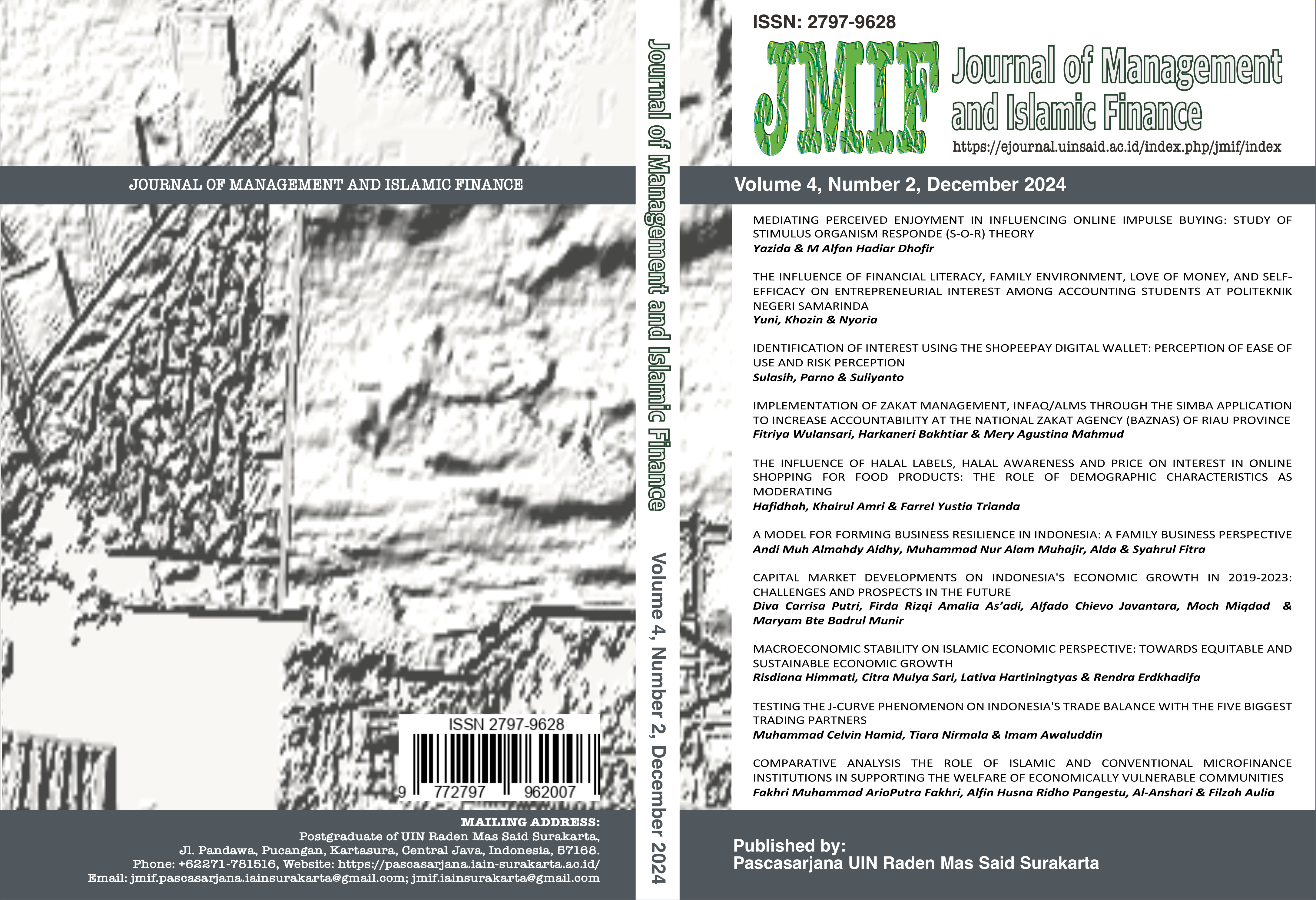CAPITAL MARKET DEVELOPMENTS ON INDONESIA'S ECONOMIC GROWTH IN 2019-2023: CHALLENGES AND PROSPECTS IN THE FUTURE
DOI:
https://doi.org/10.22515/jmif.v4i2.10176Keywords:
Sharia Capital Market, Economic Growth, Indonesia GDP, Sharia Mutual FundsAbstract
Downloads
References
Agussalim, M., Limakrisna, N., & Ali, H. (2017). Mutual Funds Performance: Conventional and Sharia Product. International Journal of Economics and Financial Issues, 7(4), 150–156.
Aisah, N., Sholahuddin, M., & Rahmawati, S. D. R. (2022). Sharia and Conventional Stock Investment. Journal of Business and Management Studies, 4(2), 464–476. https://doi.org/10.32996/jbms.2022.4.2.34
Al-Bashir, M. (2008). Sukuk Market: Innovations and Challenges. Islamic Economic Studies, 15(2), 1–22.
Aloui, C., Hammoudeh, S., & Hamida, H. Ben. (2015). Co-movement between sharia stocks and sukuk in the GCC markets: A time-frequency analysis. Journal of International Financial Markets, Institutions and Money, 34, 69–79. https://doi.org/10.1016/j.intfin.2014.11.003
Appiah, M., Idan Frowne, D. Y., & Tetteh, D. (2020). Capital Market and Financial Development on Growth: A Panel ARDL Analysis. Indonesian Capital Market Review, 12(1). https://doi.org/10.21002/icmr.v12i1.12050
Ardiansyah, H. (2017). Pengaruh Inflasi Terhadap Pertumbuhan Ekonomi Di Indonesia. Jurnal Pendidikan Ekonomi, Vol.5(No.3).
Handika, D., Rahmah, F., & Rahmatullah, N. (2024). The Role of Sharia-Compliant Financial Instruments in Promoting Economic Growth: Evidence from Indonesia. Annual International Conference on Islamic Economics and Business, 192–205.
Herlambang, A. (2020). The Performace Comparation in Indonesia: Conventional Mutual Funds vs Sharia Mutual Funds. Journal of Business Management Review, 1(5), 295–312. https://doi.org/10.47153/jbmr15.642020
Indrayani, I. (2023). Pengaruh Pengetahuan Investasi dan Motivasi Investasi Terhadap Minat Investasi di Pasar Modal. Journal of Trends Economics and Accounting Research, 3(3), 328–333. https://doi.org/10.47065/jtear.v3i3.577
Intan, E. M., Rahmawati, S., & Wibowo, M. G. (2022). Pengaruh Pertumbuhan Ekonomi Terhadap Tingkat Kemiskinan di Kawasan Barat Indonesia Periode 2016 - 2020. Jurnal Al-Iqtishad, 01(18), 65–83.
Klasen, S. (2006). Economic Growth and Poverty Reduction: Measurement Issues using Income and Non‐Income Indicators. Econstor, 142, 1–27.
Maulida, A. Z., Risdiana, R., & Purnomo, A. (2023). Performance of Indonesia’s Sharia Capital Market for the 2022 Period. Journal of Islamic Economics and Philanthropy, 5(4), 97–113. https://doi.org/10.21111/jiep.v6i2.9369
Nawindra, I., & Wijayanto, A. (2020). The Influence of Macroeconomic Variables on The Indonesian Sharia Stock Index (ISSI) for The 2013-2019 Period. Management Analysis Journal, 9(4), 402–412. https://doi.org/10.15294/maj.v9i4.41875
Oanh, T. T. K. (2024). Digital financial inclusion in the context of financial development: Environmental destruction or the driving force for technological advancement. Borsa Istanbul Review, 24(2), 292–303. https://doi.org/10.1016/j.bir.2024.01.003
Paltrinieri, A., Hassan, M. K., Bahoo, S., & Khan, A. (2019). A Bibliometric Review of Sukuk Literature. International Review of Economics and Finance, 897–918.
Pardiansyah, E. (2018). Investasi dalam Perspektif Ekonomi Islam : Pendekatan Teoritis dan Empiris Pendahuluan Dewasa ini , kita mengenal investasi “ bodong ” yang dilakukan oleh orang. Economica: Jurnal Ekonomi Islam, 8(2), 337–373.
Sugiyono. (2018). Metode Peneiltian Bisnis (Pendekatan Kuantitatif, Kualitatif Kombinasi dan R&D). In Alfabeta Bandung.
Tan, Y. L., & Mohamad Shafi, R. (2021). Capital market and economic growth in Malaysia: the role of ṣukūk and other sub-components. ISRA International Journal of Islamic Finance, 13(1), 102–117. https://doi.org/10.1108/IJIF-04-2019-0066
Tas, N., Hepsen, A., & Onder, E. (2013). Analyzing Macroeconomic Indicators of Economic Growth Using Panel Data. SSRN Electronic Journal, 2(3), 41–53. https://doi.org/10.2139/ssrn.2264388
Tryaswati, S. P., & Astuti, C. D. (2024). Pengaruh Pengetahuan Investasi, Persepsi Risiko Investasi, Dan Return Investasi Terhadap Minat Investasi Generasi Milenial Dengan Dimoderasi Teknologi Media Sosial. Value :Jurnal Ilmiah Akuntansi Keuangan Dan Bisnis, 5(1), 154–171. https://doi.org/10.36490/value.v5i1.1296
Widyastuti, U., Febrian, E., Sutisna, S., & Fitrijanti, T. (2020). Sharia compliance in sharia mutual funds: A qualitative approach. International Journal of Economics and Business Administration, 8(3), 19–27. https://doi.org/10.35808/ijeba/483
Yuni, R., & Hutabarat, Lanova, D. (2021). Dampak Perdagangan Internasional Terhadap Pertumbuhan Ekonomi Indonesia Pada Tahun 2009-2019. Dampak Perdagangan Internasional Terhadap Pertumbuhan Ekonomi Indonesia Pada Tahun 2009-2019, 10(1), 62–69.
Zulkhibri, M. (2015). A synthesis of theoretical and empirical research on sukuk. Borsa Istanbul Review, 15(4), 237–248. https://doi.org/10.1016/j.bir.2015.10.001
Downloads
Published
Issue
Section
Citation Check
License
Copyright (c) 2025 Diva Carrisa Putri, Firda Rizqi Amalia As’adi, Alfado Chievo Javantara, Moch Miqdad, Maryam Bte Badrul Munir

This work is licensed under a Creative Commons Attribution-ShareAlike 4.0 International License.
Authors who publish with this journal agree to the following terms:
- Authors retain copyright and grant the journal right of first publication with the work simultaneously licensed under a Creative Commons Attribution License that allows others to share the work with an acknowledgement of the work's authorship and initial publication in this journal.
- Authors are able to enter into separate, additional contractual arrangements for the non-exclusive distribution of the journal's published version of the work (e.g., post it to an institutional repository or publish it in a book), with an acknowledgement of its initial publication in this journal.
- Authors are permitted and encouraged to post their work online (e.g., in institutional repositories or on their website) prior to and during the submission process, as it can lead to productive exchanges, as well as earlier and greater citation of published work.






